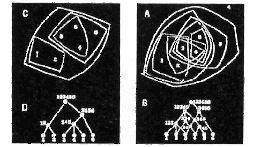|
Introduction
The essential nature of a human-made thing
when it is moved or transferred from its context can be explained by
the de-contexting or the re-contexting (i.e., when a thing presumed
to be A becomes B) of that human-made thing. Even if not accompanied
by the actual act of movement or transfer itself, this same result can
be achieved by the perpetual temporal transition of the context itself.
In general, this state of affairs is called conversion. This paper will
begin with an examination of several examples of conversion in architectural
structures of various regions and time periods as a way to explicate
the mechanism which gives potential to the unique transformed nature
of those buildings.
In past discussions, the term multiplicity,
tayôsei in Japanese, has been used to name the quality of
man-made things which allows conversion. However, this term simply notes
the ex post facto "multiple nature" of a man-made thing.
The fundamental question of why a man-made thing has the potential to
change into another man-made thing is absolutely not suggested by the
term multiplicity or tayôsei. In our analysis of the conversion
of man-made things, we must thus determine a different concept that
allows us to examine the mechanism which brings about such multiplicity
or tayôsei.
In this abstract, I would like to propose
the term "several-ness", or ikutsukasei in Japanese, as a
keyword for this concept. I would also like to explain the concepts
of "tree" and "semi-lattice" which are important
to discussions of conversion and were formulated in 1965 by Christopher
Alexander.
Tree and Semi-Lattice
Why are man-made things created with set
goals in mind capable of becoming man-made things with other goals?
The most suggestive thesis on this question in the field of architecture
and urban planning is Christopher Alexander's 1965 paper, "A city
is not a tree" (published in Design, 206, pp. 46-55 1965).
In this paper Alexander proposed the two terms "tree" and
"semi-lattice" and then subjected his proposed terms to a
critical scrutiny. These two terms represent methods for considering
how large complex systems are constructed from small systems. The differences
between these two terms can be seen in these figures (Left figure: Tree;
Right figure: Semi-lattice).
 In
a tree, each element has an unmistakable singular meaning and there
is absolutely no overlapping in the combination of these elements. A
road is a road, a foot path is a foot path. On the other hand, in a
semi-lattice each element has multiple meanings, and the elements are
layered in a variety of combinations. The semi-lattice structure of
a traditional city is what fosters the rich array of diverse life-styles
possible in that city. A road can at times be a festival space. Conversely, new cities created by planners
are trees. In other words, because humans in charge of resolving design
questions are only capable of grasping a simple, clear tree construct,
they are limited to this resolution method in their design decisions.
The limiter in this case is basic human ability. Until now these two concepts have been
utilized as completely opposing concepts. However, with the addition
of temporal difference, the semi-lattice can be interpreted as a construct
combining singular meaning states of human-made things. In other words,
if we add the concept of time (i.e.. movement or transfer of context)
we see that this supposedly opposing pair becomes successive. Thus we
see how a semi-lattice is generated from a tree, and we can call this
a superb general model of a human-made thing's conversion process.
In
a tree, each element has an unmistakable singular meaning and there
is absolutely no overlapping in the combination of these elements. A
road is a road, a foot path is a foot path. On the other hand, in a
semi-lattice each element has multiple meanings, and the elements are
layered in a variety of combinations. The semi-lattice structure of
a traditional city is what fosters the rich array of diverse life-styles
possible in that city. A road can at times be a festival space. Conversely, new cities created by planners
are trees. In other words, because humans in charge of resolving design
questions are only capable of grasping a simple, clear tree construct,
they are limited to this resolution method in their design decisions.
The limiter in this case is basic human ability. Until now these two concepts have been
utilized as completely opposing concepts. However, with the addition
of temporal difference, the semi-lattice can be interpreted as a construct
combining singular meaning states of human-made things. In other words,
if we add the concept of time (i.e.. movement or transfer of context)
we see that this supposedly opposing pair becomes successive. Thus we
see how a semi-lattice is generated from a tree, and we can call this
a superb general model of a human-made thing's conversion process.
Several-ness
Then, we might ask, why does a tree generate
another tree? This is the same as examining the basis of a human-made
thing's identity which allows that the meaning of a specific human-made
thing may change depending on time and location.
The sincere desire to convert a human-made
thing is the first essential element in conversion. The converter strips
the existing meaning and function (i.e.. context) from the human-made
thing, and then must establish that human-made thing in a new function
(context). At that time the human-made thing's materially internalized
set list of capacities or abilities guarantees the movement or transfer
of meaning and function. It is the connection between those set capacities
and abilities with other capacities or abilities which furthers the
conversion goal. To the degree that this potential for conversion is
based in material characteristics, it is neither singular nor infinite.
There are several potentials, what I have termed "several-ness,"
or ikutsukasei in Japanese. Such several-ness is infinitely combinable.
This paper will use these fundamental
concepts to depict the dynamic temporal forms found in examples of previously
converted architectural forms. (Translated by Martha J. McClintock)
back |